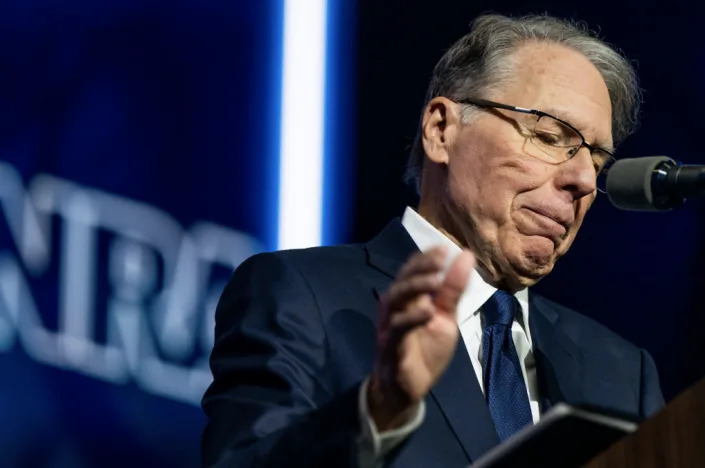Marjorie Taylor Greene groundlessly claims straight people face extinction within 150 years because of LGBTQ+ education
Mia Jankowicz
Wed, June 1, 2022

Georgia Rep Marjorie Taylor Greene speaking on a video uploaded to Facebook on May 29, 2022.Rep. Marjorie Taylor Greene/Facebook
Rep. Marjorie Taylor Greene claimed LGBTQ+ education will make straight people extinct.
She took aim at Disney and a children's educator, calling them "trans terrorists."
86.7% of people in the US consider themselves straight, a figure changing only gradually.
Rep. Marjorie Taylor Greene predicted that identifying as heterosexual will be a thing of the past within a period of less than 200 years thanks to LGBTQ-inclusive sex educators, who she called "trans terrorists."
"They just want you to think that all of a sudden the entire population is steadily turning gay or turning trans," said the Georgia representative, who sailed through her primary race to win the GOP nomination on May 24.
Greene cited no evidence for the apparently chronic decline of heterosexuality. 86.3% of Americans consider themselves straight, according to a 2022 Gallup poll.
Gallup has noted that it is still an open question over whether the generational increases are due to "a true shift in sexual orientation" or whether it "reflects a greater willingness of younger people to identify as LGBT."
In a video, Greene said: "Just generation, generation ... probably in about four or five generations no-one will be straight any more. Everyone will be either gay, or trans, or nonconforming or whatever list of fifty of sixty options which there are."
A generation is typically taken to mean around 30 years — making Greene's ballpark around 120 to 150 years.
A short segment of Greene's speech was shared by the Twitter account Patriot Takes:
The comments came as part of "MTG Live," an almost hour-long video uploaded to Facebook on May 29.
On Wednesday, after Insider contacted Facebook for comment, a company spokesperson said "the video has now been removed for violating our policies."
The video had been viewed more than 16,000 times and had been shared more than 500 times.
In it, Greene targeted Disney and Rachel E. Simon, a psychotherapist who wrote a book titled: "The Every Body Book: The LGBTQ+ Inclusive Guide for Kids about Sex, Gender, Bodies and their Families."
Greene, showing a brief clip of Simon discussing her book, used this as one basis on which to claim that "the most dangerous people in America" are those that "want to groom your children and talk them into changing their gender."
"This people are terrorists because they're going after the most innocent, vulnerable people in our country," she said. In the brief clip of Simon talking about her book, there was no mention of attempting to persuade children into gender reassignment.
Greene also took aim at Disney, which has come under fire from conservatives for LGBTQ-inclusive programming in what has shaped up to be an anti-"woke" culture war.
She shared a brief clip of a Disney show named "Dino Ranch" in which two animated male dinosaurs gaze longingly at egg-shaped rocks and appear to want to become fathers.
The show's creator Matt Fernandes said in an interview with parenting website Romper.com that his intention was to "have a dialogue about the fact that families come in different shapes and sizes."
This sort of representation, Greene said, is "sick, it's disgusting, it's evil, and it's wrong."
She said that she "could care less what grown adults do" and that sexuality is a private matter.
Greene has a long history of transphobic comments and stunts, in particular the false suggestion that transgender people are replacing people assigned female at birth.
In March, she suggested she feels "threatened" by HHS official Rachel Levine, the highest-ranking openly transgender official in the US.
Greene's office did not immediately respond to Insider's request for comment.
Flashcard uproar shows NC Republicans really do want you to stop saying gay

N.C. House Speaker Tim Moore's office

the Editorial Board
Tue, May 31, 2022
When North Carolina Republicans introduced their “Parents’ Bill of Rights,” they explicitly said it wasn’t “anti-gay,” but an effort to address the concerns of parents about what is being taught at schools.
“Nothing more. Nothing less,” Senate leader Phil Berger said the day the bill was announced. They said the bill wouldn’t allow sexuality or gender identity to be part of the curriculum in kindergarten through third grade, but if such topics came up organically, that wasn’t prohibited. It wasn’t, Republicans stressed, a “don’t say gay bill.”
But Friday, House Speaker Tim Moore and Rep. Erin Paré published a news release saying that a series of flashcards used to teach preschool-aged children colors were not “age-appropriate materials.”
The cards, produced by the company BuyUs Box, depicted different types of families. The color “white” depicts a smiling, happy couple wearing white. One of the people has short hair, is wearing a white button-down over a white shirt, and is visibly pregnant. The partner, however, is visibly more feminine. In the news release and later on Fox News, Paré, who is up for re-election, criticized the “pregnant man” on the flashcard, even though that isn’t described on the card and isn’t discernible from the picture. The card may not even be depicting a trans man and his cis partner — it could also be two cis women.
Either way, that’s apparently not appropriate.
Instead of settling the matter with the preschool teacher, or the principal, or even the school district, a parent called Paré to inform her of the cards. After the ensuing uproar, the bullied teacher quit.
It’s a clear signal that, despite saying otherwise, Republicans aren’t just looking to curtail sex education or history classes from teaching about gender or bodies or the gay rights movement. They want these conversations to stop altogether, even if it’s just in passing reference.
If the flash cards depicted a cisgender, heterosexual couple — a pregnant woman and her husband, or a husband and wife with their kids — then no one would be complaining. Why is being gay or trans somehow PG-13 or inappropriate?
The cards are not pornographic or crass. They all feature smiling families of different sizes, genders, races, and abilities. They all look happy and loved. That is what “age-appropriate” LGBTQ+ teaching is about: love is what makes a family a family.
What’s more disappointing is that Wake County Schools have called the flash cards “inappropriate.” It sends a message to LGBTQ+ parents and children in the school system: their existence, and the way they exist in the world, is inappropriate. Which, it seems, is exactly the message some Republicans want to deliver.

N.C. House Speaker Tim Moore's office
the Editorial Board
Tue, May 31, 2022
When North Carolina Republicans introduced their “Parents’ Bill of Rights,” they explicitly said it wasn’t “anti-gay,” but an effort to address the concerns of parents about what is being taught at schools.
“Nothing more. Nothing less,” Senate leader Phil Berger said the day the bill was announced. They said the bill wouldn’t allow sexuality or gender identity to be part of the curriculum in kindergarten through third grade, but if such topics came up organically, that wasn’t prohibited. It wasn’t, Republicans stressed, a “don’t say gay bill.”
But Friday, House Speaker Tim Moore and Rep. Erin Paré published a news release saying that a series of flashcards used to teach preschool-aged children colors were not “age-appropriate materials.”
The cards, produced by the company BuyUs Box, depicted different types of families. The color “white” depicts a smiling, happy couple wearing white. One of the people has short hair, is wearing a white button-down over a white shirt, and is visibly pregnant. The partner, however, is visibly more feminine. In the news release and later on Fox News, Paré, who is up for re-election, criticized the “pregnant man” on the flashcard, even though that isn’t described on the card and isn’t discernible from the picture. The card may not even be depicting a trans man and his cis partner — it could also be two cis women.
Either way, that’s apparently not appropriate.
Instead of settling the matter with the preschool teacher, or the principal, or even the school district, a parent called Paré to inform her of the cards. After the ensuing uproar, the bullied teacher quit.
It’s a clear signal that, despite saying otherwise, Republicans aren’t just looking to curtail sex education or history classes from teaching about gender or bodies or the gay rights movement. They want these conversations to stop altogether, even if it’s just in passing reference.
If the flash cards depicted a cisgender, heterosexual couple — a pregnant woman and her husband, or a husband and wife with their kids — then no one would be complaining. Why is being gay or trans somehow PG-13 or inappropriate?
The cards are not pornographic or crass. They all feature smiling families of different sizes, genders, races, and abilities. They all look happy and loved. That is what “age-appropriate” LGBTQ+ teaching is about: love is what makes a family a family.
What’s more disappointing is that Wake County Schools have called the flash cards “inappropriate.” It sends a message to LGBTQ+ parents and children in the school system: their existence, and the way they exist in the world, is inappropriate. Which, it seems, is exactly the message some Republicans want to deliver.











